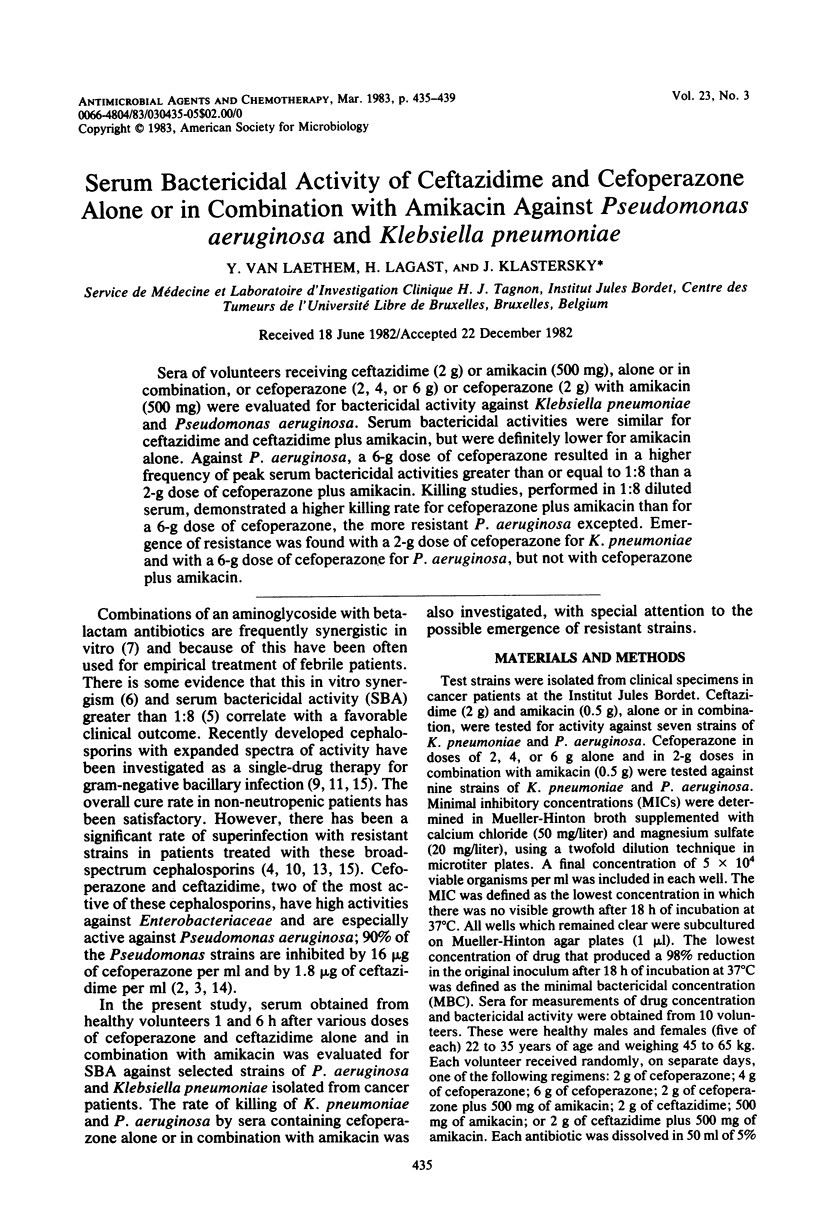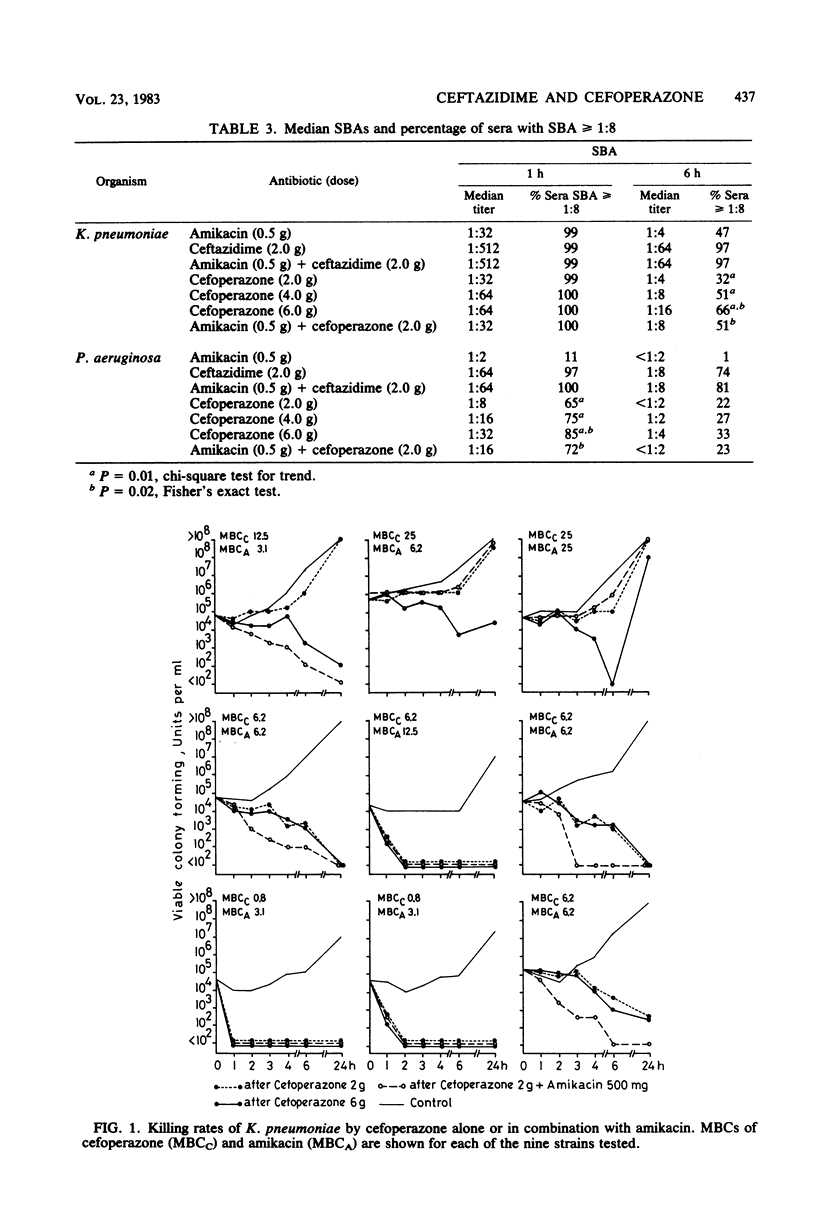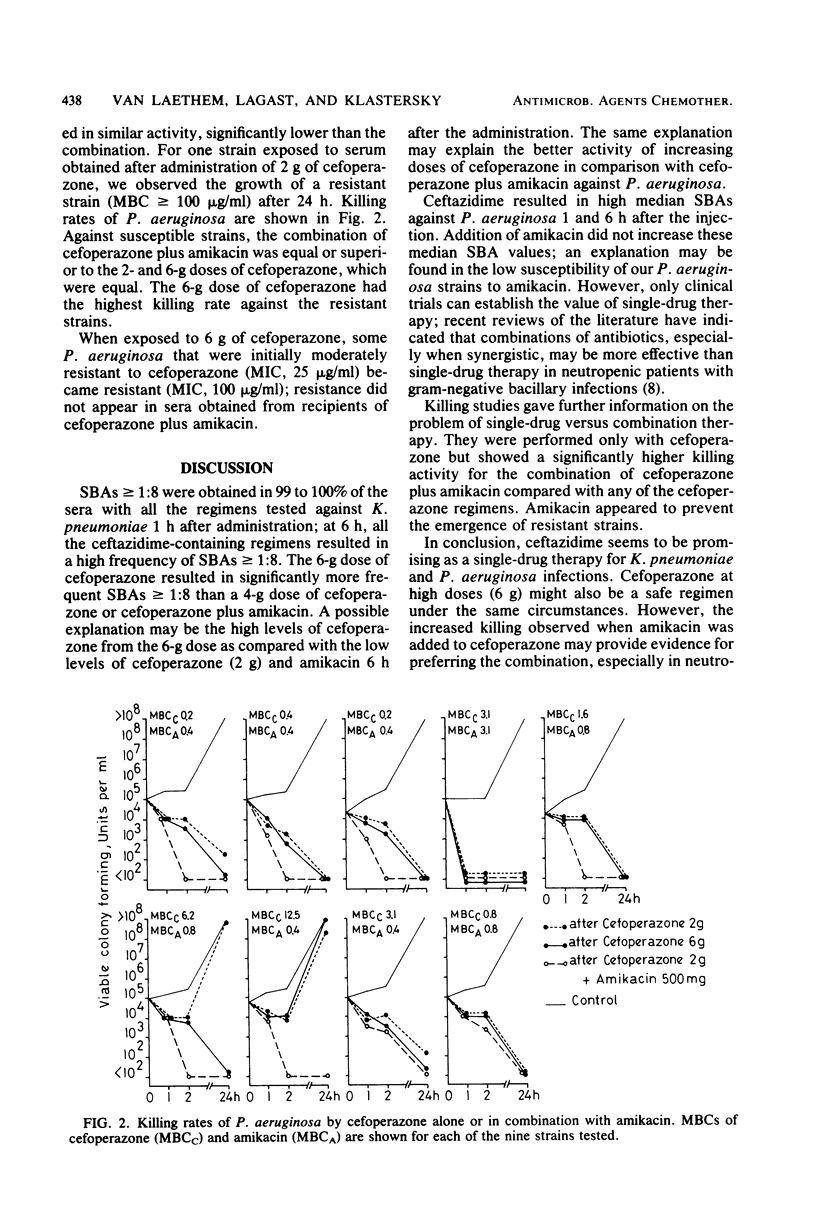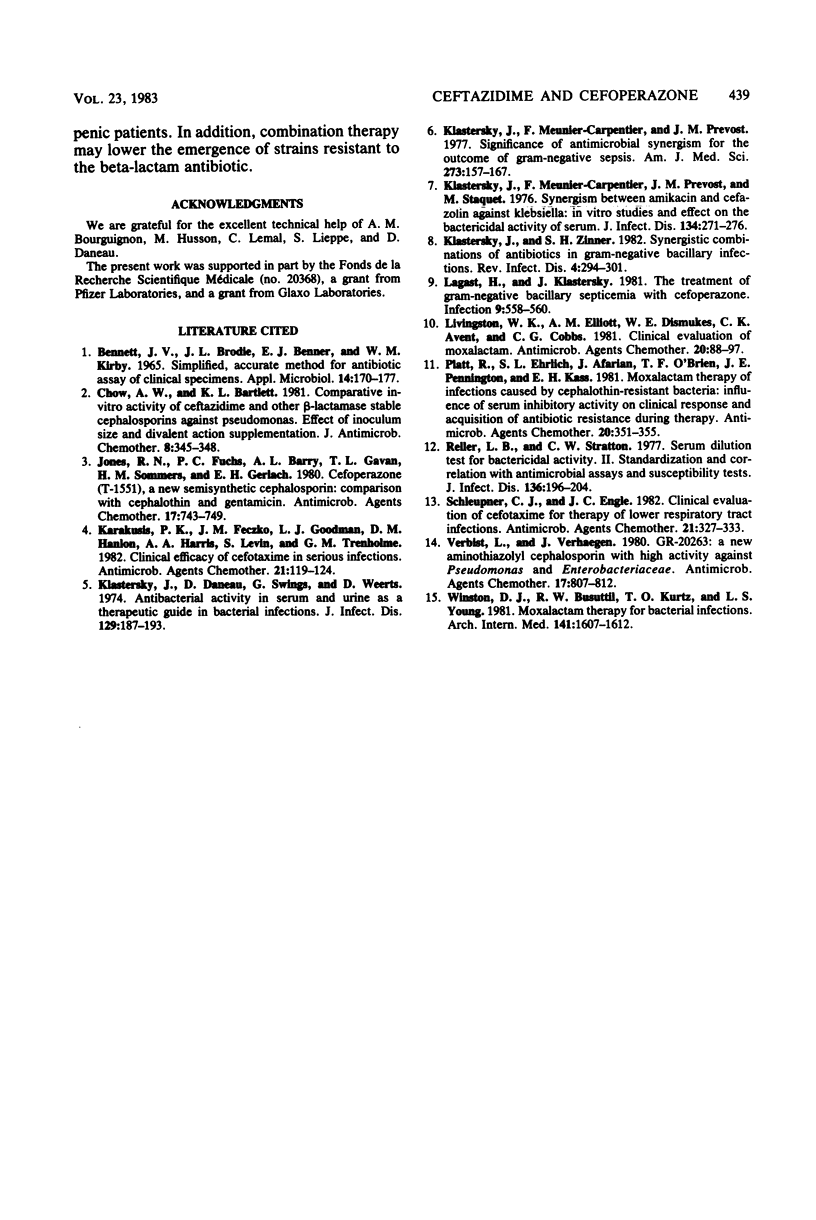Abstract
Sera of volunteers receiving ceftazidime (2 g) or amikacin (500 mg), alone or in combination, or cefoperazone (2, 4, or 6 g) or cefoperazone (2 g) with amikacin (500 mg) were evaluated for bactericidal activity against Klebsiella pneumoniae and Pseudomonas aeruginosa. Serum bactericidal activities were similar for ceftazidime and ceftazidime plus amikacin, but were definitely lower for amikacin alone. Against P. aeruginosa, a 6-g dose of cefoperazone resulted in a higher frequency of peak serum bactericidal activities greater than or equal to 1:8 than a 2-g dose of cefoperazone plus amikacin. Killing studies, performed in 1:8 diluted serum, demonstrated a higher killing rate for cefoperazone plus amikacin than for a 6-g dose of cefoperazone, the more resistant P. aeruginosa excepted. Emergence of resistance was found with a 2-g dose of cefoperazone for K. pneumoniae and with a 6-g dose of cefoperazone for P. aeruginosa, but not with cefoperazone plus amikacin.
Full text
PDF




Selected References
These references are in PubMed. This may not be the complete list of references from this article.
- Bennett J. V., Brodie J. L., Benner E. J., Kirby W. M. Simplified, accurate method for antibiotic assay of clinical specimens. Appl Microbiol. 1966 Mar;14(2):170–177. doi: 10.1128/am.14.2.170-177.1966. [DOI] [PMC free article] [PubMed] [Google Scholar]
- Jones R. N., Fuchs P. C., Barry A. L., Gavan T. L., Sommers H. M., Gerlach E. H. Cefoperazone (T-1551), a new semisynthetic cephalosporin: comparison with cephalothin and gentamicin. Antimicrob Agents Chemother. 1980 Apr;17(4):743–749. doi: 10.1128/aac.17.4.743. [DOI] [PMC free article] [PubMed] [Google Scholar]
- Karakusis P. H., Feczko J. M., Goodman L. J., Hanlon D. M., Harris A. A., Levin S., Trenholme G. M. Clinical efficacy of cefotaxime in serious infections. Antimicrob Agents Chemother. 1982 Jan;21(1):119–124. doi: 10.1128/aac.21.1.119. [DOI] [PMC free article] [PubMed] [Google Scholar]
- Klastersky J., Daneau D., Swings G., Weerts D. Antibacterial activity in serum and urine as a therapeutic guide in bacterial infections. J Infect Dis. 1974 Feb;129(2):187–193. doi: 10.1093/infdis/129.2.187. [DOI] [PubMed] [Google Scholar]
- Klastersky J., Meunier-Carpentier F., Prevost J. M. Significance of antimicrobial synergism for the outcome of gram negative sepsis. Am J Med Sci. 1977 Mar-Apr;273(2):157–167. doi: 10.1097/00000441-197703000-00005. [DOI] [PubMed] [Google Scholar]
- Klastersky J., Meunier-Carpentier F., Prevost J. M., Staquet M. Synergism between amikacin and cefazolin against Klebsiella: in vitro studies and effect on the bactericidal activity of serum. J Infect Dis. 1976 Sep;134(3):271–276. doi: 10.1093/infdis/134.3.271. [DOI] [PubMed] [Google Scholar]
- Klastersky J., Zinner S. H. Synergistic combinations of antibiotics in gram-negative bacillary infections. Rev Infect Dis. 1982 Mar-Apr;4(2):294–301. doi: 10.1093/clinids/4.2.294. [DOI] [PubMed] [Google Scholar]
- Livingston W. K., Elliott A. M., Dismukes W. E., Avent C. K., Cobbs C. G. Clinical evaluation of moxalactam. Antimicrob Agents Chemother. 1981 Jul;20(1):88–97. doi: 10.1128/aac.20.1.88. [DOI] [PMC free article] [PubMed] [Google Scholar]
- Platt R., Ehrlich S. L., Afarian J., O'Brien T. F., Pennington J. E., Kass E. H. Moxalactam therapy of infections caused by cephalothin-resistant bacteria: influence of serum inhibitory activity on clinical response and acquisition of antibiotic resistance during therapy. Antimicrob Agents Chemother. 1981 Sep;20(3):351–355. doi: 10.1128/aac.20.3.351. [DOI] [PMC free article] [PubMed] [Google Scholar]
- Reller L. B., Stratton C. W. Serum dilution test for bactericidal activity. II. Standardization and correlation with antimicrobial assays and susceptibility tests. J Infect Dis. 1977 Aug;136(2):196–204. doi: 10.1093/infdis/136.2.196. [DOI] [PubMed] [Google Scholar]
- Sahn S. A., Good J. T., Jr, Reller L. B. Cephradine concentrations in serum, pleural fluid, pleura, and lung of normal rabbits. J Antimicrob Chemother. 1981 Oct;8(4):345–346. doi: 10.1093/jac/8.4.345. [DOI] [PubMed] [Google Scholar]
- Schleupner C. J., Engle J. C. Clinical evaluation of cefotaxime for therapy of lower respiratory tract infections. Antimicrob Agents Chemother. 1982 Feb;21(2):327–333. doi: 10.1128/aac.21.2.327. [DOI] [PMC free article] [PubMed] [Google Scholar]
- Verbist L., Verhaegen J. GR-20263: a new aminothiazolyl cephalosporin with high activity against Pseudomonas and Enterobacteriaceae. Antimicrob Agents Chemother. 1980 May;17(5):807–812. doi: 10.1128/aac.17.5.807. [DOI] [PMC free article] [PubMed] [Google Scholar]
- Winston D. J., Busuttil R. W., Kurtz T. O., Young L. S. Moxalactam therapy for bacterial infections. Arch Intern Med. 1981 Nov;141(12):1607–1612. [PubMed] [Google Scholar]


